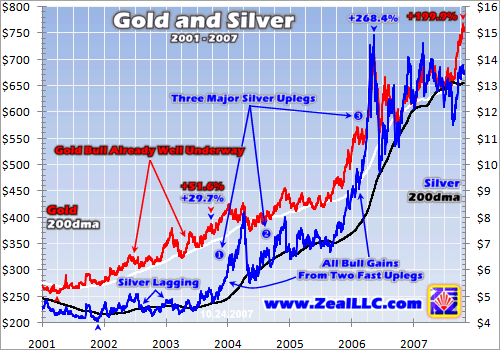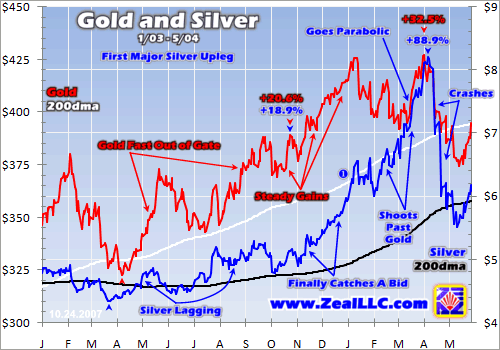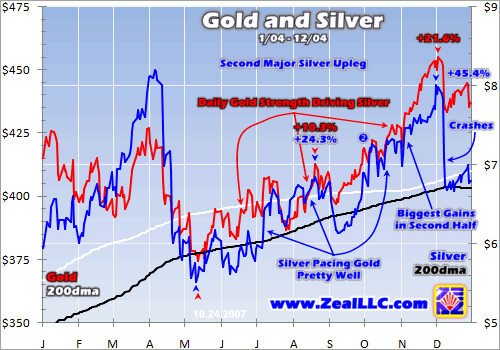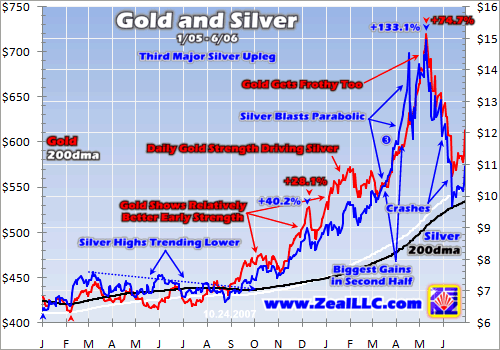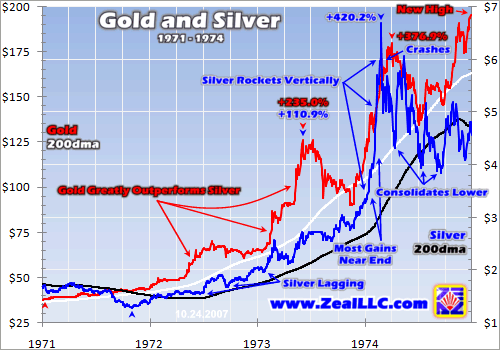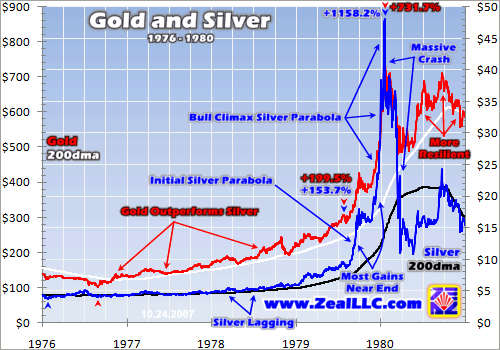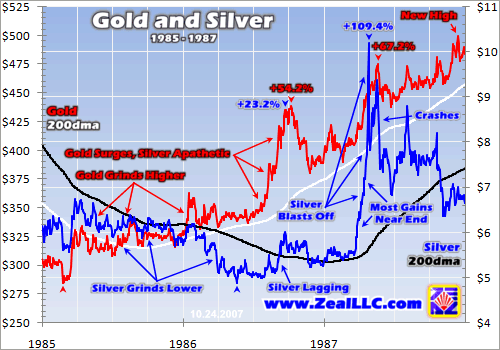|
|
|||||||
|
|
|
|
|
|
|
|
|
|
Silver Lagging Gold Adam Hamilton October 26, 2007 4290 Words
Since the middle of August alone, gold has powered 18% higher driving a 40% rally in the HUI gold-stock index. Just a week ago the Ancient Metal of Kings closed near $768, its highest nominal levels seen since its famous January 1980 super spike. And both gold and HUI seasonals now argue for more gains in the months ahead. Today really is the best of times for gold investors.
Despite this good fortune, a nagging doubt is gnawing away at the minds of many traders. Silver, which tends to run higher with gold, has not been confirming goldís move. While gold carves majestic new bull highs, silver hasnít even come close yet to exceeding its May 2006 high of just under $15. Though it has run 20% higher at best since mid-August, barely beating goldís gains is considered a failure for silver.
If silver was underperforming merely over the last couple months, it would be easier to dismiss. But this metal has been weak all year. While gold climbed higher in a definite uptrend in 2007, silver actually ground lower in a contrary downtrend! Year-to-date as of their mid-August lows, gold was up almost 3% while silver was over 10% lower. Can a gold upleg without silver confirming and following be legitimate?
Silver is known historically for wildly exceeding goldís gains, so traders have very high expectations for it. They expect to see it not only rally with gold, but to amplify goldís gains. A non-confirmation of goldís strength by silver is widely perceived as a subtle warning sign, proof that something important is missing in the precious-metals sector. Today this perception has ballooned into a belief that goldís rally is somehow flawed or false, likely to fail suddenly, since silver hasnít come along for the ride.
If you own physical silver and elite silver stocks like me, silver lagging gold has a very tangible financial impact on your portfolio. It is frustrating watching very-high-potential silver stocks fall far behind their peers mining gold. And even if you only play the gold side of precious metals, the fears silver is sparking definitely bleed into gold in the form of negative psychology which retards its own advance. So the persistent silver underperformance has wide-ranging ramifications across the entire PM realm.
After many discussions about this with other speculators and investors, I realized that I didnít understand the historical interaction between gold and silver well enough. In order to attempt to determine how serious and anomalous silverís relative underperformance to gold has been in 2007, I really needed to dig into the metalsí interrelationship historically. This essay details my explorations, which happened to significantly alter my expectations for silver going forward.
The raw speculative potential for silver is so extreme that a kind of mythos has developed around the metal. Some of the popular silver lore is true, but over the passage of decades since the last silver super bull incorrect assumptions have crept in too. Silver enthusiasts, including me, have mentally condensed the metalís modern history in a way that distorts our expectations for its future performance.
By taking a careful look at silverís performance relative to gold in both this bull and bull runs from decades past, I hope to realign my own expectations for silver closer to reality. Silver truly does have incredible potential to soar, but its gains are much less linear than goldís. Silver tends to soar in fits and starts, sitting around doing nothing for a long time before suddenly rocketing stratospheric with little or no warning.
In my historical study of the interrelationship between silver and gold, I looked at several dozen charts covering 1970 to today. Unfortunately I had to narrow these down to seven charts for this essay. Each of these charts renders the silver price in blue superimposed over the gold price in red. The best place to start for realigning the silver-mythos expectations with silver reality is our current precious-metals bulls.
Not remembered by many, even in this bull market silver has substantially lagged gold. This secular gold bull stealthily launched near $256 back in April 2001. But even with gold slowly clawing higher again, silver didnít bottom until November 2001 just over $4. In the early years of this gold bull, 2002 and most of 2003, silver largely just ground sideways oblivious to goldís advance. By late 2003, gold was up 52% bull-to-date while silverís own bull had only run 30% higher. Silver performed poorly relative to gold for years.
Then suddenly starting in late 2003, silver caught a bid. It soared in a massive parabolic upleg before crashing in early 2004. A second major upleg immediately erupted, but it failed in late 2004 before silver could achieve new highs. And then throughout most of 2005, silver consolidated sideways to lower while gold slowly continued higher on balance. The third major silver upleg started rocketing higher in late 2005 and culminated in the metalís bull high just under $15 in May 2006.
Now if you examine the red line, goldís bull ascent was pretty linear between 2001 and 2005. It made steady progress higher with relatively little drama. Gold did soar in late 2005 as it transitioned into Stage Two where it is driven by global investment demand instead of the dollar bear, but prior to that its progress had been pretty conservative. This is a radical contrast to silverís bull-to-date behavior.
Silver, which was coined ďthe restless metalĒ by Roy Jastram in 1981, has certainly lived up to its moniker in this bull. Despite the silver bull technically running for six years now, virtually all of its gains were seen in just two fast uplegs. Most of its run from $4 to $8 happened in just two quarters straddling the dawn of 2004. And most of its run from $8 to $15 happened in just two more quarters crossing the beginning of 2006.
So over the six years of this silver bull, hypothetically one could have reaped almost all the gains by only being deployed for two separate periods running about six months each. Almost all of silverís gains in this bull have come from two fast uplegs alone! Silverís spastic behavior made for a couple half-years of excitement surrounded by five years of boredom. Silver investors must understand that silverís gains are generally not linear and steady, but relatively rare and sharp.
The next three charts zoom in to look at gold and silver in each of the latterís major uplegs in its bull to date. While uplegs 1 and 3 rendered above are quite obviously important since they account for almost all of silverís bull gains, upleg 2 is also worthy of study. Despite popular perceptions today, silver has tended to lag gold even within the white metalís strongest runs higher of this entire bull.
If you werenít in silver or silver stocks before late 2003, believe me they were pretty uninspiring until silver was finally bid over $5 for good then. Silverís first major upleg of this bull actually started in March 2003, slightly ahead of goldís upleg of the time. But starting in April, gold surged out of the gate and left silver in the dust. Silver was climbing higher gradually, but it couldnít keep pace with goldís gains. By the middle of these parallel uplegs, gold was up 21% while silver was only up 19%. Sound like today?
But after the halfway point of this upleg, silver finally caught a bid. It shot past gold in early 2004 and went parabolic. Ultimately in this upleg silver blasted 89% higher while gold was only up by a third. This is the kind of huge silver outperformance of gold that traders expect. But the key to refining these expectations is that silver lagged well into goldís upleg. Speculators didnít really start flooding into silver until long after gold started higher.
And after its parabola topped, silver crashed. It plummeted 33% in one month, with almost half of these losses in the first week alone. Meanwhile gold also corrected, but its decline was much more moderate at 12% and it was more resilient post-crash. This behavior of silver, going parabolic late in a gold upleg and then crashing, is very typical. It is also very important as it is the key to understanding how silver tends to work.
Compared to gold, silver is a tiny market. And there arenít vast above-ground hoards of silver like goldís to cushion its moves. Silver is also hyper-speculative. While it does have many important industrial uses, when push comes to shove it is speculative buying that drives silverís biggest and sharpest price moves. Only speculative buying can drive vertical parabolic ascents, and only panic speculative selling can drive crashes. Supply-and-demand fundamentals simply shift far too slowly to drive such extreme moves.
So much becomes clear when silver is considered from a speculatorís perspective. Early on in gold uplegs, greed is low and speculators are skeptical that the gold upleg is for real. Without much greed or excitement, they arenít interested in silver. But the longer that gold powers higher, the more speculators start to think the upleg is real and sustainable. So gradually at first they start buying silver. By the second half of the gold upleg the small silver market really explodes on the flood of bids and greed ultimately fuels a parabola. But once all the speculators are in, profit-taking selling overwhelms bids and silver collapses.
Whether or not I should have considered silverís mid-2004 upleg as major is debatable since it didnít hit new highs, but it sure is interesting regardless. Following its crash in April 2004 after upleg 1, silver immediately started higher in upleg 2. Note that almost all of silverís daily gains happened on days when gold was up. It is rising gold prices on a daily basis that drive speculative interest in silver, seldom the other way around. In the end, silver is always relegated to riding goldís coattails.
Midway through this upleg, silver was up 24% while gold was up 10%. By the end of this upleg, silver was up 45% while gold was only up 22%. In this upleg, after the initial couple months where it lagged a bit, silver generally outpaced goldís gains on the order of 2 to 1. Despite its relatively gradual ascent, silverís biggest gains were still witnessed in the second half of its upleg. As usual, silver bidding was highest later after greed had a chance to set in.
Such parallel linear gains, with silver leveraging gold, are what traders tend to expect from silver. But as the rest of these charts below show, silver pacing gold so well is actually something of an anomaly. Believe it or not, it is this pacing that is atypical behavior compared to history. Usually silver lags gold for a long time, then greed suddenly kicks in, and silver explodes vertically and rapidly catches and exceeds goldís gains in a short period of time.
At the end of this upleg, silver crashed again. It is this crash that makes me think this upleg is major. Once again crashes can only happen when speculators bid a price up too high and too fast and then too many try to get out at once. Greed and fear extremes define uplegs and drive their wild price swings. In December 2004, silver plummeted 17% in just over a week. Gold fell too, but it was much more resilient as usual since it is far less speculative than silver.
These silver crashes are crucial to consider too. It is always funny, as after every single silver crash silver futures traders write me and bemoan their enormous losses. They willingly chose to play a hyper-volatile and capricious commodity with margin, and then they are amazed when their leverage works against them. Make no mistake, if you decide to live by the sword by leveraging silver prices you had darned well better be ready to die by the sword too. Silver has a long history of brutal and sudden crashes as excessive greed near tops rapidly turns to black fear. Silver traders must expect periodic crashes!
Silverís last major upleg which ended in 2006 was its biggest and most important by far. Fully 2/3rds of silverís entire bull market gains occurred between mid-November 2005 and early May 2006! It was this magnificent run that really got investors and speculators fired up about silver again. Naturally silver stocks had stupendous gains too as they were frantically bid higher on silverís exciting strength.
Now since this chart doesnít have zeroed axes, it looks like silver paced goldís gains pretty well. Indeed it did in a day-by-day sense, generally rallying when gold rallied and pulling back when gold retreated. But by early December when gold was carving exciting new bull highs, silverís performance really wasnít all that impressive. Gold was up 28% in its upleg while silver was just up 40%, not far beyond gold. This was certainly not the major outperformance silver traders were looking for.
Also interesting to note is that silver trended lower for most of 2005 despite gold grinding sideways to higher. The lagging silver behavior we have witnessed this year in 2007 looks an awful lot like silverís behavior in 2005. This is a crucial lesson too. Silver is primarily a speculative sentiment play, so just because it is long lethargic doesnít mean it is not right on the verge of soaring. Once goldís gains stoke general PM greed to a hot-enough level, inevitably silver will catch a bid and explode.
And once again here, silverís greatest gains accrued in the second parabolic half of its upleg. It ultimately powered 133% higher in this third major upleg which easily exceeded goldís 75% run. Provocatively gold also went parabolic at the end of this run for the first time in its bull. And since gold was driven vertical by greed, pure speculative buying, it also crashed just like silver tends to do. The parabola-crash cycle is the most classic signature of heavy speculative buying followed by big selling straddling major interim highs.
Now that we have examined this silver bull to date, I have had to realign my own expectations. Unlike gold which tends to rise fairly linearly, silver tends to lag gold considerably early on in uplegs before rocketing higher later to catch up with and surpass it. Silver really doesnít offer much excitement until enough speculators believe a parallel gold upleg is the real deal. So it is generally in the second half of gold uplegs, as faith in gold returns, that capital starts flowing into silver futures again and bidding up its price.
And you know what, these should have been our expectations for silver all along. Its modern historical record is much the same, albeit even more extreme. Despite the silver mythos which has conveniently edited out all this hyper-volatile and spastic history, silver didnít do all that much in the 1970s and 1980s until late in major gold bull runs. Silver will ultimately follow goldís lead like it always does. But it usually takes some pretty serious gold moves to ignite speculative fervor in silver.
Between 1971 and 1974, which is probably around when the majority of todayís silver speculators were being born, the precious metals awoke from a long slumber and launched a mighty bull run. While some remember the spectacular 1974 silver high, few remember the bumpy road silver took to get there. Between 1971 and 1973, gold greatly outperformed silver. Silver was lagging gold tremendously for most of this run.
While the red and blue lines above really highlight this silver underperformance visually, the raw gains empirically verify it. By mid-1973, gold was 235% higher while silver was only up 111%. Today if we saw silver merely double while gold tripled, it wouldnít surprise me to see mass suicides in the silver camp. It would utterly shatter the hardcore silver bullsí psyches to see their beloved silver lag gold to such a horrendous degree.
But finally in late 1973, speculators started believing the gold run was for real so they piled into silver to play this smaller market. Once again over 2/3rds of silverís total bull gain in this run occurred in just its final couple of months in early 1974. Silverís parabolic ascent from just over $3 to just under $7 in early 1974 utterly dwarfs anything we have seen in our current bull. By the end of this tremendous run, silver was up 420% which sounds awesome. But amazingly gold wasnít all that far behind at 377%.
Not only did gold easily beat silver for most of this bull, since silverís gains were more parabolic it crashed right after unlike gold. While silver struggled and consolidated lower as speculators contended with their own greed and fear, gold soon carved a new even higher high in late 1974. Dťjŗ vu? Today in 2007 traders are worried because silver isnít testing new highs while gold is. But there is nothing new under the sun in the financial markets because they will always be driven by the same greed and fear.
So even in the early 1970s, silver was a spastic speculation. It lagged gold for years before suddenly rocketing higher in a speculative mania in the end to catch up. And then it promptly crashed. Silverís consolidation-parabola-crash cycles we have witnessed since 2003 are just echoes of this restless metalís usual behavior stretching back decades.
Certainly the cornerstone of the popular silver-outperforming-gold mythos stems from the entirety of the 1970s precious-metals bull. From their early 1970s lows to January 1980, silver gained 3627% while gold ďonlyĒ gained 2332%. On a closing basis silver went from $1.29 to $48.00, 37x higher, while gold went from $34.95 to $850.00, 24x higher. So yes, silver certainly did outperform gold in the 1970s bull. But the devil is in the now-forgotten details as always.
This chart shows the second half of that 1970s bull run, from 1976 to 1980. Once again for several years gold handily outperformed silver. By mid-1979, gold was up 200% since 1976 while silver lagged well behind at 154%. Then suddenly through two massive parabolas that each lasted a matter of months, silver soared vertically. Of its fabled run from just over $1 to just under $50, fully $40 of it happened in just the last five months or so of silverís entire bull market! If you totally ignored silver until August 1979, theoretically you could have still reaped 4/5ths of its entire gains of the 1970s!
So was silver a better investment than gold during the 1970s as popularly believed? Certainly technically yes. But this was only true for a half year straddling the dawn of 1980 when silver rocketed parabolic in its greed-driven speculative-mania bull climax before promptly collapsing in a massive crash. Just like today, back then silver tended to do nothing exciting for years and then suddenly explode in a greedy frenzy that just as quickly dissipated when it was over.
After the silver and gold super spikes of late 1979, both metals crashed. But since silverís gains were far more speculative and less fundamentally sound, it plummeted much farther than gold. And provocatively, from 1976 to early 1980 in the second half of this bull of legend, silver ran 1158% higher while gold ran 732% higher at their respective bubble peaks. While silverís outperformance was indeed substantial, it certainly didnít approach the 2-to-1 leverage a lot of traders expect today.
More than any of my other research on silver lagging gold this week, this chart bothers me. I constantly hear silver advocates describing the 1970s as if silverís gains were more linear, spread out, and practically achievable for a trader of the time like goldís. But when 4/5ths of silverís entire decade-long bull run happens in just five months, the metal seems far more appropriate for gun-slinging speculators than investors. Exquisite timing was necessary to ride this super spike.
If your expectations are for silver to make smooth linear gains like gold, you really ought to consider resetting them to expect lots of boredom with periodic stunning parabolas. Silver will still be a great investment, but it will require lots of patience and nerves of steel to hold it long enough, and then sell it quick enough, to capture these parabolas. All throughout modern history silver has usually waited until late in gold bulls/uplegs to really shine and show its true colors.
This final chart highlights a little-remembered precious-metals bull in the mid-1980s. It is interesting because this is a cyclical, not a secular, move. Yet silver exhibits the exact same type of lagging-gold behavior in this mid-secular-bear environment that it did in both the 2000s and 1970s secular bulls.
It all started in 1985, when gold ground higher while silver bucked the gold strength and ground lower. So is 2007 all that odd, to see silver not responsive to gold strength? Definitely not in light of history. While this gold bull started higher in early 1985, silver didnít join the party until mid-1986 when speculators finally started getting interested in the precious metals again. By midway in this run, gold was 54% higher while silver lagged far behind at 23%.
And then yet again in early 1987 silver exhibited its characteristic hyper-speculative behavior. While gold continued higher in a nice fairly linear fashion, silver exploded vertically. Almost all the gains of this entire silver upleg occurred at the very end. Ultimately silverís 109% gain would handily exceed goldís 67% gain. But silver really only outperformed gold for the last five weeks of a gold bull that ran for over two years!
After this silver parabola in early 1987, not surprisingly it promptly crashed. The kind of greed that can drive vertical ascents is simply never sustainable. Meanwhile, since gold was more fundamentally driven, it retreated modestly but didnít crash. And late 1987 again highlights silverís incredibly speculative nature. As the US stock markets crashed, silver was dragged down with them. Speculators were universally scared and wanted nothing to do with any speculative trades, period.
But while silver languished, gold soon rose to a new high after the 1987 crash. Although silver has largely been a speculatorsí playground for all of modern history, gold offered safety and strength in a very trying time. This just underlines the crucial point that in terms of price action silver is not just like a more-volatile version of gold. Since greed and fear have a far greater influence on its price than fundamentals, silver is a radically different beast entirely than gold.
To be honest with you, at this point I feel let down and misled. All my life I have drank the Kool-Aid of the silver mythos that states it should outperform gold most of the time. Yet this is just not true in history. Regardless of what you or I want to believe about silver, the historical data is crystal clear. Yes, silver does tend to outperform gold at the very end of precious-metals moves when popular greed waxes extreme. But before those climaxes silver tends to lag gold considerably for the majority of the total time these moves take.
In light of this revelation, silverís underperformance in 2007 shouldnít frighten any precious-metals investor or speculator. It is simply par for the course. Silver will more than likely fly during this gold upleg, but most of its move higher will start in the later months after goldís own run has already restored confidence, bullishness, and greed to PM speculators. Silver will eventually surge to catch up with gold in its own good time. All silverís non-confirmation of goldís run today signals is an absence of general PM greed so far, which is a good thing since it suggests this gold upleg remains young.
At Zeal we have long invested in and speculated in physical silver and silver stocks. I first recommended physical silver as an investment to our subscribers in November 2001 when it traded at $4.20. One of our long-term silver-stock investments, recommended in April 2002, is now up about 1200%. So our capital has long been deployed in silver and elite silver stocks and will remain so until the end of this commodities bull a decade or so into the future.
But for individual gold uplegs, this research will alter my trading strategy. Early on in gold uplegs, speculators will probably get better results in gold stocks. Silver stocks should do best later in gold uplegs after goldís strength restores general greed to silver futures speculators so they start driving up silver prices. If you want to mirror our own actual silver-stock trades in this gold upleg, please subscribe today to our acclaimed monthly newsletter. It is where we actually apply our research to profitable real-world trading.
The bottom line is thereís a little too much myth in the popular silver mythos today about it outperforming gold. While silver does tend to soar and surpass gold near the end of any given major move, most of the time it lags significantly early on before general greed takes root. This makes sense, as the silver market is so tiny compared to goldís that it is much more susceptible to wild swings driven by pure speculative trading. Silver is a weathervane reflecting PM greed and fear.
While this long-established silver behavior doesnít alter long-term bullishness on silver one bit, it really should readjust trader expectations. Like soldiers describing war as mostly boredom punctuated by occasional sheer terror, so is silver trading. We need to expect long periods of boring consolidations and relative underperformance to gold before silver suddenly shoots parabolic and earns us fortunes within months.
Adam Hamilton, CPA October 26, 2007 Subscribe |
|||||||
|
|
|
|
|
|
|
|
|
|
|
|
|
|
|
|||

